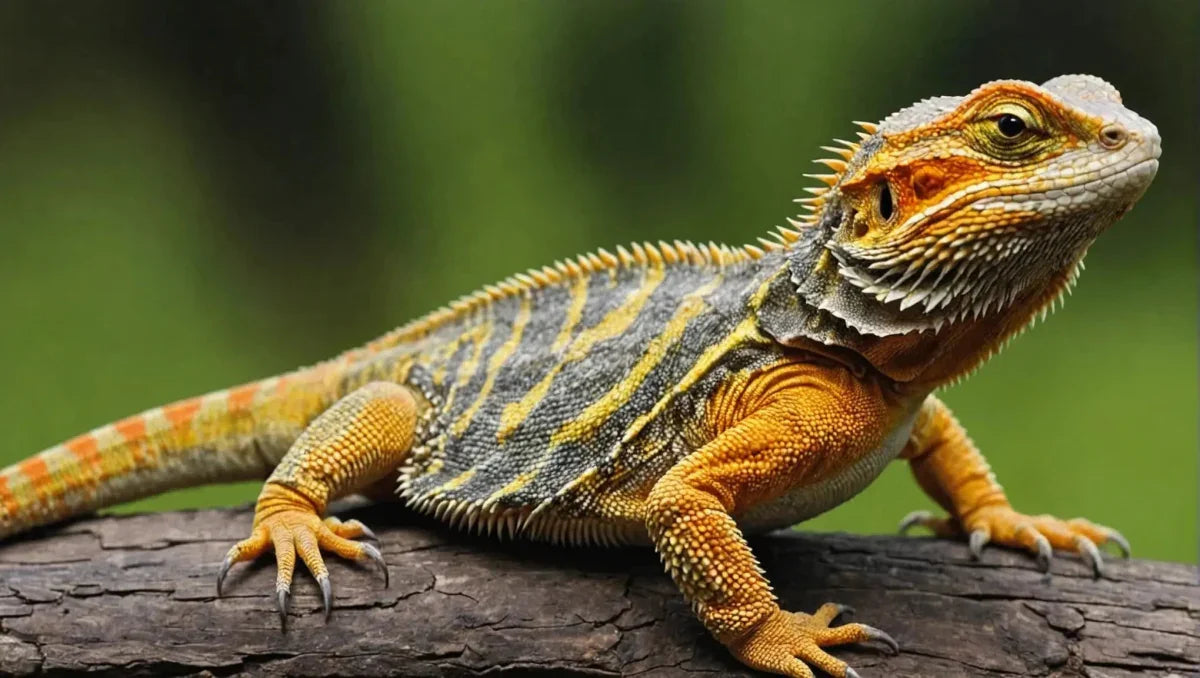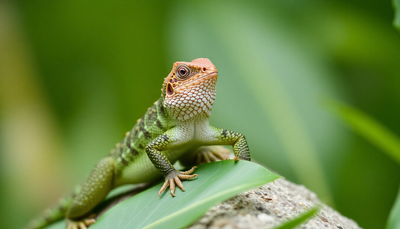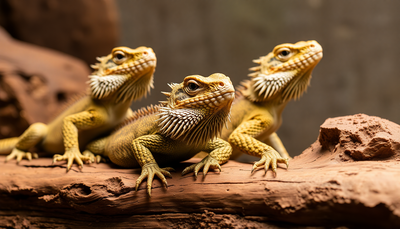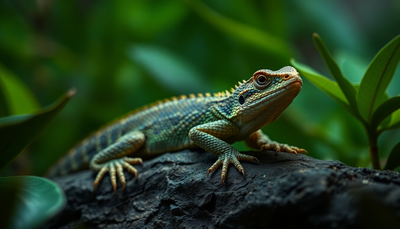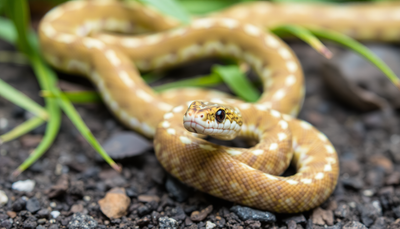Welcome to the fascinating world of bearded dragons! These captivating creatures make excellent pets, but they do require specific care.
One crucial aspect of bearded dragon care is maintaining the right temperature in their habitat. As ectothermic reptiles, bearded dragons rely on external heat sources to regulate their body temperature.
Understanding and providing the optimal temperature ranges for your bearded dragon is essential for their health and well-being. It aids in digestion, metabolism, and overall comfort.
In this guide, we'll delve into the specifics of creating the perfect environment for your bearded dragon. We'll discuss the ideal temperature ranges for both day and night, and how to achieve them.
We'll also explore the tools you can use to monitor and adjust temperatures, and common mistakes to avoid.
So, whether you're a new pet owner or just looking to enhance your bearded dragon's habitat, this guide is for you. Let's get started!
Understanding Bearded Dragon Thermoregulation
Bearded dragons are intriguing reptiles that need external heat sources to regulate their body temperature. This process is known as thermoregulation, a vital function for their health.
By controlling their body heat, bearded dragons can keep their metabolism and digestion running smoothly. This requires a well-designed habitat offering various temperature zones. Proper thermoregulation ensures bearded dragons can engage in normal activities without stress.
Achieving this balance requires understanding their need for both warm basking areas and cooler zones. With such an environment, your bearded dragon can thrive, displaying natural behaviors and remaining active.
Creating the Perfect Basking Spot
A basking spot is a cozy sunbathing area where your bearded dragon can absorb heat. It should be the warmest part of their environment. This area helps them digest food effectively and maintain energy levels.
To create the ideal basking spot, ensure it stays between 95-110°F (35-43°C). This warm zone mimics the natural heat they'd experience in the wild. Here are some essentials for the perfect basking spot:
- Basking lamp: Provides direct heat for efficient warming.
- Stable platform: Allows safe sunbathing.
- UVB lighting: Supports vitamin D3 synthesis for strong bones.
With these components, you're setting the stage for a healthy bearded dragon experience.
The Cool Zone: Balancing Your Bearded Dragon's Habitat
The cool zone is vital for temperature balance within your bearded dragon's habitat. It offers a retreat from the intense basking heat. This area allows them to regulate their body temperature by moving between warm and cool zones.
Aim for the cooler zone to be between 75-85°F (24-29°C) during the day. This range ensures your dragon can choose the perfect spot for comfort. Consider the following when setting up this zone:
- Shaded areas: Provide relief from direct heat.
- Stable hide: Offers security and relaxation.
- Gradual transition: Ensures easy movement between temperature zones.
With a well-designed cool zone, you're promoting natural behavior and overall well-being.
Nighttime Temperatures: Ensuring Comfort After Dark
When the sun sets, maintaining the right nighttime temperatures becomes crucial. Bearded dragons need cooler temperatures to rest and replenish. However, be sure not to let it drop too low.
Ideal nighttime temperatures range from 65-75°F (18-24°C). This gentle decrease mimics natural conditions and keeps your dragon comfortable. A ceramic heat emitter or low-watt heat lamp can provide consistent warmth during cooler nights.
Keeping nighttime temperatures within this range prevents your bearded dragon from becoming stressed or lethargic. A stable environment during the night is essential to their health and helps ensure they wake refreshed and energetic.
Monitoring and Adjusting: Tools for Temperature Management
To keep your bearded dragon's habitat optimal, regular temperature checks are a must. Accurate measurements prevent unexpected fluctuations that could stress your pet. Thankfully, a few trusty tools can make this task easy.
Consider these essential tools for temperature management:
- Digital Thermometers: For quick and reliable readings.
- Infrared Temperature Guns: Great for checking surface temperatures.
- Thermostats: Maintain stable heat levels automatically.
These tools allow precise monitoring and adjustments to your bearded dragon's environment. Regularly review your setup, ensuring each zone maintains the ideal temperature range. This vigilance keeps your scaly friend healthy and content.
Seasonal Adjustments and Special Considerations
As seasons change, so do temperature needs in your bearded dragon's habitat. Warmer months may require less artificial heating, while winter might demand extra warmth. Staying aware of these shifts ensures your dragon stays in its comfort zone.
Consider these seasonal adjustments:
- Winter Heating: Ensure additional heat sources like ceramic emitters are ready.
- Summer Cooling: Monitor to prevent habitat overheating due to external temperatures.
- Daylight Variations: Adjust light cycles to mimic natural day length.
Each season presents unique challenges in maintaining an ideal environment. By anticipating these changes and preparing in advance, you can ensure your bearded dragon remains healthy and content, no matter the time of year.
Avoiding Temperature Extremes: Safety Tips
Temperature extremes can pose serious risks to bearded dragons. High temperatures can lead to overheating, while too-cold conditions can affect digestion and immune function. Preventing these extremes is crucial for your dragon's safety.
Here are some key safety tips:
- Use Thermostats: Automatically manage heating devices to prevent dangerous spikes.
- Avoid Direct Sunlight: Keep the habitat away from windows to prevent overheating.
- Regular Monitoring: Check thermometers daily to catch any fluctuations promptly.
By implementing these safety measures, you can protect your bearded dragon from harmful temperature extremes. Consistent vigilance ensures a stable and cozy habitat, reducing risks of stress and health problems.
The Role of Humidity in Bearded Dragon Habitats
While temperature is critical, humidity also plays a role in bearded dragon well-being. These desert dwellers thrive in low humidity environments, typically between 30-40%. Higher humidity can lead to respiratory issues and mold growth in their habitat.
Maintaining the correct humidity levels requires regular monitoring. Use a hygrometer to check the humidity inside the enclosure. If levels are too high, increase ventilation or reduce water features. On the flip side, if the environment is too dry, you might need to lightly mist the habitat or provide a moist hide to aid shedding. Balance is key for a comfortable and healthy bearded dragon environment.
Common Mistakes to Avoid in Temperature Regulation
Even dedicated pet owners can make errors in setting up their bearded dragon's environment. Avoid common mistakes to ensure your dragon's health. Inconsistent temperatures and drastic changes can stress your reptilian friend. This stress may lead to health problems like lethargy or poor digestion.
Here is a list of common pitfalls to watch out for:
- Using unreliable temperature gauges: Always rely on accurate digital thermometers.
- Neglecting to provide a temperature gradient: Ensure a range of temperatures within the habitat.
- Allowing temperatures to drop too low at night: Keep nighttime temperatures within the safe range.
- Positioning habitats near direct sunlight: This can cause dangerous overheating.
- Overlooking seasonal adjustments: Modify settings as needed with weather changes.
Staying aware of these mistakes will help maintain a stable and safe environment for your bearded dragon.
Conclusion: Maintaining Optimal Temperatures for a Happy Bearded Dragon
Creating the right environment is crucial for your bearded dragon's health. By maintaining optimal temperature ranges, you ensure your dragon's comfort and vitality. Stay informed and attentive to their needs, making necessary adjustments as needed. With proper care, your bearded dragon will thrive in their warm, welcoming habitat.


